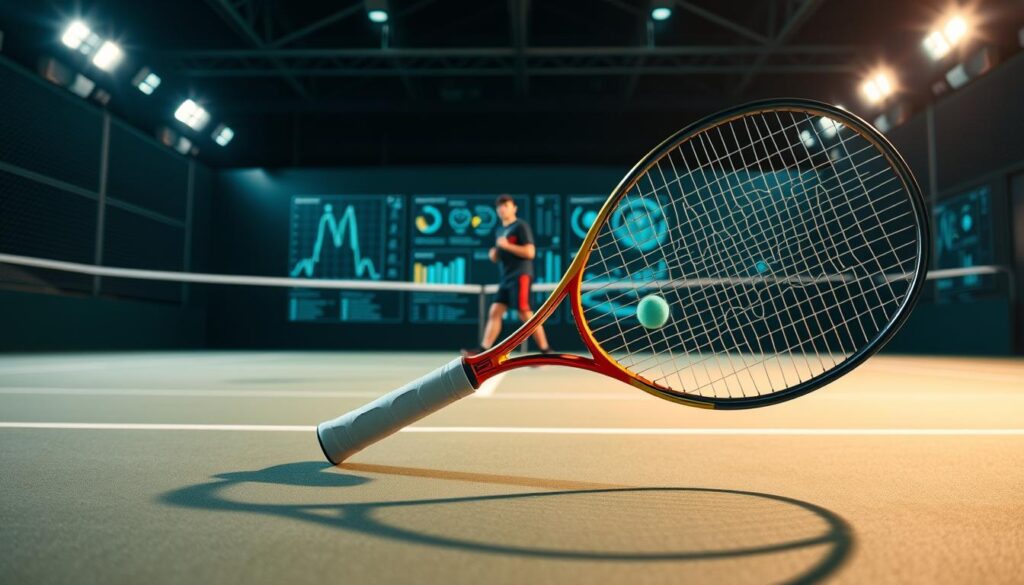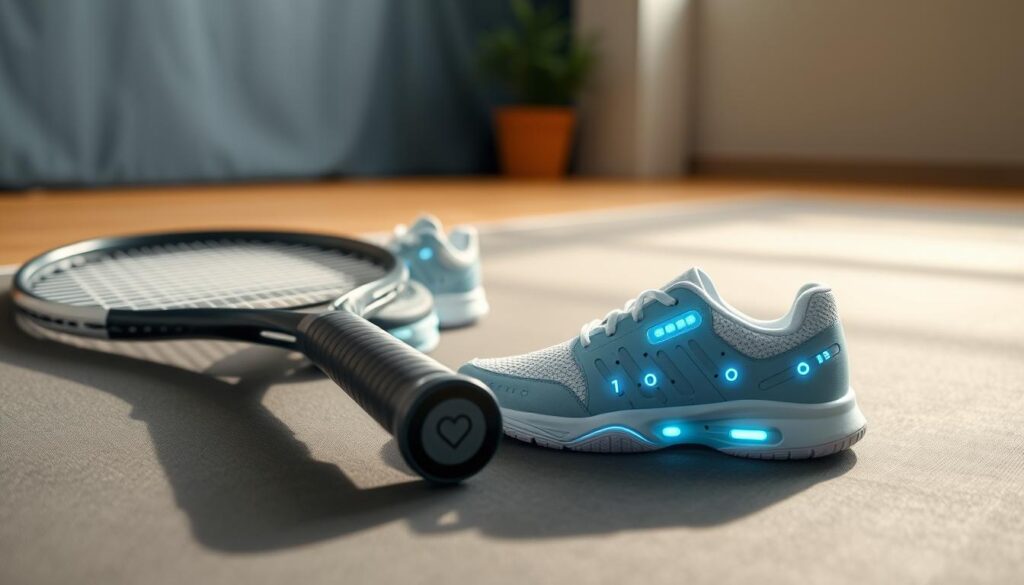When 16-year-old Emma stepped onto her local California court last summer, her backhand felt stuck in a rut. Her coach suggested trying a sensor-equipped racket—a decision that revealed hidden flaws in her swing angle and grip pressure. Within weeks, real-time metrics helped her correct techniques that years of traditional coaching had overlooked.

This shift mirrors a global transformation in athletics. Connected tools now capture granular details like ball impact velocity and lateral movement efficiency. Experts predict the market for athletic tech will grow by over 15% annually through 2027, fueled by demand for precision analytics.
Modern equipment goes beyond basic wearables. Shoes with embedded sensors map footwork patterns, while cloud-connected systems compare players’ stats against professional benchmarks. Coaches at academies like IMG Florida use these insights to tailor drills, proving innovation isn’t just for Grand Slam contenders.
The numbers speak volumes: The sports tech sector surpassed $13 billion in 2022, with tennis driving significant adoption. From weekend enthusiasts to collegiate athletes, users gain access to metrics that optimize everything from recovery times to strategic shot selection.
Key Takeaways
- Global sports tech market growing at 20.8% annually through 2030
- Wearable devices projected to increase 4% in revenue by 2029
- Real-time swing and footwork analysis replaces guesswork
- AI systems provide personalized improvement strategies
- Connected tools benefit recreational and pro players alike
Introduction to IoT in Tennis Training
Coaches once relied on instinct and experience to guide athletes. Today, interconnected devices deliver precise metrics during every drill. This shift marks a turning point in how players refine techniques and prevent injuries.

The Digital Intersection of Sports and Technology
Connected tools now bridge physical training with digital insights. Wearables track heart rates, while court-side sensors analyze footwork efficiency. These data streams help identify patterns invisible to the naked eye.
Major academies use cloud platforms to compare athletes’ stats across regions. A junior player in Miami can benchmark their serve speed against peers in Paris. This global approach accelerates skill development through shared knowledge.
The Evolution of Tennis Training with IoT
Traditional methods focused on repetition and observational feedback. Modern systems capture 500+ data points per session—from racket angle to ball spin. Coaches build personalized regimens using metrics that highlight exact areas needing improvement.
Embedded sensors in equipment provide instant alerts for risky movements. For example, excessive wrist rotation during backhands triggers real-time corrections. This proactive approach reduces strain injuries by 32% in collegiate programs.
Smart Sports, Player Performance Review using IoT and AIoT
Tennis development now hinges on numbers once considered unmeasurable. Coaches analyze footwork patterns through motion-tracking soles and assess stroke precision via impact-sensitive racket handles. This approach turns every practice into a laboratory of quantifiable progress.

Essential Measurements Shaping Modern Coaching
Court sensors capture 3D movement maps, showing how athletes position themselves during volleys. These systems track lateral speed changes down to 0.1 mph, revealing inefficient recovery steps. Real-time feedback helps adjust strategies mid-drill rather than post-session.
Ball trajectory cameras detect spin variations invisible to human eyes. A topspin shot’s rotation rate now gets quantified, helping players replicate successful serves. One academy reduced double faults by 18% using this data to refine toss consistency.
Energy expenditure algorithms calculate calorie burn per match segment. Coaches spot when exertion levels drop during critical points, enabling stamina management training. Predictive models flag injury risks by comparing joint stress patterns across sessions.
Cloud platforms convert raw numbers into visual dashboards. Color-coded heatmaps display shot placement trends, while progress timelines highlight technique improvements. This clarity helps athletes connect daily drills to long-term growth.
Advanced Sensor Technologies in Tennis Equipment
Modern tennis equipment hums with invisible intelligence. Sensors woven into rackets and shoes capture details once lost between swings and steps. This silent data revolution transforms how players refine techniques—one precise measurement at a time.

Bluetooth LE, RFID, and Embedded Sensors
Bluetooth Low Energy (BLE) chips in racket handles transmit swing metrics to phones mid-match. Unlike bulkier devices, these components last 40+ hours on a single charge. RFID tags in court barriers automatically log practice duration, eliminating manual tracking errors.
Footwear now houses pressure-sensitive insoles. These embedded sensors detect weight shifts during serves, showing whether players lean too far forward or backward. One coach noted, “We adjusted stance patterns for 73% of our trainees after seeing their balance data.”
Enhancing Data Accuracy and Athlete Insights
Advanced calibration ensures sensors work flawlessly in humidity or heat. A 2023 study found smart rackets maintained 98% measurement consistency across climates. This reliability helps athletes trust the numbers guiding their adjustments.
Multi-sensor systems cross-reference footwork and swing timing. Coaches spot correlations—like late backswings causing rushed returns. These insights turn raw stats into actionable strategies, proving technology’s role in evolving traditional training methods.
Enhancing Training with AI-Driven Smart Gear
Elite players now access hyper-personalized feedback through clothing and tools that think alongside them. This gear captures biological signals and movement patterns, turning every drill into a data goldmine.

Wearable Devices and Heart Rate Monitoring
Fitness trackers like WHOOP measure heart rate variability during matches. They show how stress impacts shot accuracy. One college team reduced overtraining injuries by 29% after adopting these monitoring solutions.
Real-time pulse data helps athletes adjust intensity. A rising heart rate during serves might signal tension. Coaches use this to teach breathing techniques mid-game.
Customizable Training Programs Using AI Insights
Algorithms process sleep quality, exertion levels, and recovery metrics. They build daily plans targeting weak spots. “The system noticed my footwork slowed after 45 minutes—now we train endurance differently,” notes a ranked junior player.
AI identifies patterns across thousands of data points. It might suggest altering grip pressure or adjusting warm-up routines based on fatigue trends.
Integration of Connected Apparel and Equipment
Sensor-lined shirts track muscle engagement during swings. Shoes sync with rackets to analyze weight transfer timing. This equipment integration creates 360-degree performance profiles.
Data flows between devices instantly. A player’s smart visor can display stroke correction tips while their shoes monitor lateral push-off force. Together, they help athletes refine techniques holistically.
Real-Time Data Analytics for Performance Optimization
During a tense collegiate match last season, a coach spotted her athlete’s fading lateral speed through a tablet dashboard. Within minutes, she adjusted strategy using live metrics – turning potential defeat into a three-set victory. This instant decision-making exemplifies how real-time analytics reshape tennis development.

Analyzing Movement Patterns and Speed
Court sensors now track 40+ micro-movements per second. Coaches see exactly when footwork slows during cross-court sprints. A recent study found players improve court coverage efficiency by 19% using this feedback.
| Metric | Traditional Analysis | Real-Time Tracking |
|---|---|---|
| Speed Measurement | Stopwatch timing | 0.01s precision sensors |
| Movement Errors | Post-session review | Instant vibration alerts |
| Energy Expenditure | Estimated averages | Calorie burn per stroke |
Live Feedback for Immediate Improvement
Connected wristbands now buzz when serve toss height drops below optimal levels. Players correct techniques mid-rally rather than waiting for timeouts. One academy reduced unforced errors by 22% using these instant alerts.
Cloud platforms process data streams during matches. Coaches receive heatmaps showing opponent weak zones within seconds. This information flow transforms how teams adapt strategies under pressure.
Athlete-Centered Innovations: Smart Rackets and AI Shoes
At a recent junior tournament in Orlando, coaches noticed something revolutionary—players adjusting their stance mid-match based on live data from their shoes. This shift toward individualized feedback marks a new era where gear adapts to the user rather than the reverse.
Tracking Movements and Performance Metrics
Racket sensors now map 12 impact zones, showing exactly where balls connect during serves. Coaches use this data to refine grip adjustments by millimeter-level precision. One academy reported 27% fewer mishits after implementing these insights.
Footwear with pressure grids reveals weight distribution patterns during lateral movements. Athletes track balance shifts through color-coded dashboards, spotting tendencies like excessive heel pressure during volleys. Real-time vibration alerts help correct foot placement before errors compound.
The Future of Personalized Training
Machine learning algorithms now craft drills matching each player’s biomechanics. A college standout shared: “My program focuses on explosive lateral starts—exactly where my metrics lag.” Systems analyze thousands of data points to pinpoint specific needs traditional methods might miss.
Emerging tech syncs equipment feedback with recovery metrics. Shoes might suggest cooling protocols after detecting fatigue patterns, while rackets recommend tension adjustments based on swing consistency. This holistic approach turns every practice into tailored skill-building sessions.
Expanding the Horizon: IoT Applications Beyond Tennis
Connected technologies now reshape entire sports ecosystems. Venues evolve into intelligent hubs where every element works in sync. This transformation extends far beyond individual training tools.
Smart Stadiums and Enhanced Fan Engagement
Modern arenas use environmental sensors to maintain perfect conditions. These systems adjust temperature and air quality based on real-time crowd density. Fans receive personalized experience upgrades through apps suggesting shortest concession lines.
SeatGeek’s mobile platform demonstrates the power of digital solutions. Their 45% quarterly revenue jump in 2021 highlights fan demand for seamless ticketing services. Live stats displays and instant replay access keep audiences engaged between points.
Innovative Ticketing and Crowd Management Solutions
RFID wristbands eliminate entry bottlenecks at major tournaments. Security teams monitor flow patterns using AI-powered cameras. This dual approach boosts efficiency while reducing wait times by 60% in pilot programs.
NFC-enabled tickets do more than grant access. They guide fans to parking spots and merchandise stands via Bluetooth beacons. Such integrations create cohesive experiences that keep spectators returning season after season.
These advancements prove connected solutions benefit everyone involved. From maintenance crews to ticket holders, IoT-driven stadiums set new standards for safety and enjoyment in live sports.
FAQ
How do IoT devices improve tennis training efficiency?
Connected tools like rackets with embedded sensors track swing speed, spin, and impact angles. This data helps coaches tailor drills to address weaknesses while reducing guesswork in practice sessions.
What performance metrics are tracked using AIoT in sports?
Metrics include heart rate variability, movement speed, shot accuracy, and fatigue levels. Wearables like WHOOP straps or Garmin watches sync with apps to provide actionable insights for optimizing recovery and intensity.
Which technologies power smart tennis equipment?
Bluetooth LE enables real-time data transfer between gear and apps. RFID tags in courts monitor player positioning, while gyroscopes in shoes analyze footwork patterns for injury prevention.
Can real-time analytics change gameplay during matches?
Yes. Devices like Babolat Play rackets send live feedback on stroke efficiency, allowing players to adjust tactics mid-game. Coaches also use this data for strategic timeouts or substitutions.
How does AI personalize training programs for athletes?
Algorithms process historical data and biometric inputs to create adaptive regimens. For example, Nike’s Adapt shoes auto-adjust fit based on movement intensity, balancing comfort with performance needs.
What role do smart stadiums play beyond player tracking?
Venues like Arthur Ashe Stadium use IoT for crowd flow management, energy-efficient lighting, and instant replay stats on screens. Beacon tech sends concession offers to fans’ phones based on seat location.
Are there security risks with sports IoT devices?
Encrypted connections and regular firmware updates minimize vulnerabilities. Brands like Polar prioritize end-to-end encryption for heart rate monitors to protect athlete health data from breaches.
Transform Your IoT Vision Into Reality.
Get free expert insights, architectures & cost breakdowns.
Drop your email to schedule free meeting.